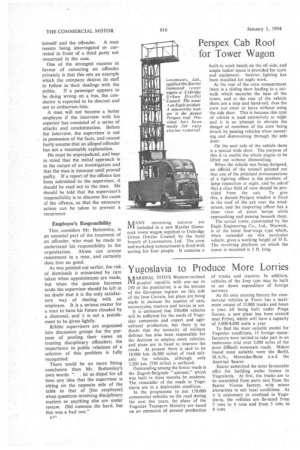Yugoslavia to Produce More Lorries
Page 44

If you've noticed an error in this article please click here to report it so we can fix it.
AARSHAL TITO'S Western-inclined LVL peoples' republic, with one car to 250 of the population, is at the bottom of the European register on this side of the Iron Curtain, but plans are being made to increase the number of cars, motorcycles, tractors and lorries in use. It is estimated that 250,000 vehicles will be sufficient for the needs of Yugoslav commerce and export and agricultural production, but there is no doubt that the necessity of military defence has also been responsible for the decision to employ more vehicles, and plans are in hand to improve the roads. At present there is said to be 10.000 km. (6.500 miles) of road suitable for vehicles, although only 1,200 km. (750 miles) is surfaced. Outstanding among the better roads is the Zagreb-Belgrade " autoput," which was built in three months by students. The remainder of the roads in Yugoslavia are in a deplorable condition. In the programme to put 150.000 commercial vehicles on die road during the next five years, the plans of the Yugoslav Transport Ministry are based on an extension of present production of trucks and tractors. In addition, vehicles of the Jeep type may be built to cut down expenditure of foreign currency. As the only existing factory for commercial vehicles at Tesno has a maximum output of 15,000 trucks and buses a year, all being built under Praga licence, a new plant has been erected near Priboj, which will have a capacity of 5,000-8,000 units a year. To find the most suitable model for Yugoslav conditions, 15 foreign manufacturers were invited to take part in an endurance trial over 5,000 miles of the most difficult mountain roads. Makes found most suitable were the Berlit, M.A.N., Mercedes-Benz a n d the Austrian Saurer. Saurer submitted the most favourable offer for building under licence in Yugoslavia. At first, the trucks are to be assembled from parts sent from the Saurer Vienna factory, with minor alterations to suit local conditions. As it is customary to overload in Yugoslavia, the vehicles are de-rated from 7 tons to 6 tons and from 5 tolls to 4 tons.




























































































